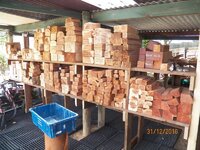G'day Brad,
I have been using epoxy resin for some years now, this will be the 4th brand of epoxy resin I bought from my regular supplier in Adelaide, the brands have changed due to various factors, availability and prices would be an important factor but quite honestly, I have never cut threads in any of the blanks I've made but I can try on the Bio-resin I'm using now, and my metric dye set and the largest size I have which may be about 12mm or so.
What type of threads will make a big difference in my opinion, superfine threads may be difficult. All epoxy's I have used are the fast set type, I don't know the differences between the fast and slow set but I wouldn't be surprised if the slow set epoxy will allow better threading, what I can tell you before I try to thread one of my blanks is that epoxy resin in fast set does "soften", become "flexible" to a point exposed to heat so preventing causing any heat while threading this resin type would be an absolute necessity.
For CNC work (the reason I started to use epoxy and not PR) the difference is considerable, the cuts come up cleaner and sharper if the cutters are sharp and if they are not turning too fast and the CNC has no cooling capabilities.
If you would like to try cutting the threads yourself with the gear you have and not having to by some of this epoxy resin to cast some blanks, I can send you some pieces for you to try, one thing I will remind you and others that you would need to wait for a minimum of 7 days to an ideal 14 days curing time before attempting to cut the threads, the extra hardness resulting from complete curing will probably be the difference between success and failure.
Good luck,
Cheers
George

